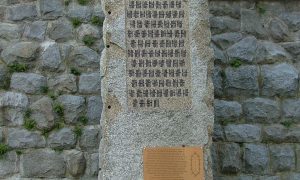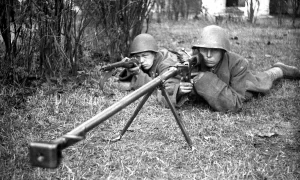On June 22, 1941, the Red Army had 53 armored trains. According to other data in the Red Army there are 34 light and 13 heavy armored trains, of which 12 light and 5 heavy armored trains are in the Far Eastern Front (Far Eastern Front ) and the Trans-Baikal District (ZabVO), plus a frame for the formation of another 10 armored trains. There were only 28 air defense armored platforms (of the SPU-BP type), of which 15 were in the Far Eastern Fleet and ZabVO. In addition to the Red Army , the NKVD troops for the protection of railway structures and the NKVD operational troops had armored trains , they have 25 armored locomotives , 32 artillery armored platforms, 36 motor armored cars and 7armored vehicles on the railway.

PVO-4 Armored Train at the Central Armed Forces of the USSR
Due to the evacuation of the only pre-war manufacturer of armored trains – the Bryansk plant Profintern , it was necessary to begin the construction of armored trains at steam locomotive and car repair plants and in railway depots. Typical drawings of armored platforms and armored locomotives (a simplified version of what was done in Bryansk before the war) were sent to factories under the name “NKPS-42”. But not everyone followed these blueprints. Sometimes local resources did not allow to follow the pattern, and the armored train was “sculpted from what it was”. Somewhere, on the contrary, they believed that they could build better – a typical example is armored train No. 1 “For Stalin”, built by the Kolomna plant. Its most distinctive feature is a special armored locomotive, rebuilt from a shunting locomotive of the 9P series with the addition of two axles, taking into account the specifics of the load of the armored locomotive. All other armored trains in the Great Patriotic War (like most trains to the Civil) used standard steam locomotives of the Ov or Od series. The famous engineer Lebedyansky was in charge of perestroika. Two armored platforms had a low silhouette (unlike all pre-war ones) and were each armed with two turrets from the newest T-34 tank ( F-34 cannon with divisional gun ballistics). Platform armor 45 mm, as on the T-34. There were three more anti-aircraft armored platforms – two with 37-mm cannons and one with a 12.7-mm DShK machine gun…. It is doubly insulting that such a powerful armored train was killed in the very first battle, colliding with the Germans on October 11, 1941 near Gzhatsk. Probably the most famous of the Soviet armored trains was “Zheleznyakov”who defended Sevastopol. Armed with 5 76-mm guns and 4 mortars and manned by seamen of the Black Sea Fleet, “Zheleznyakov” made more than 140 combat missions. The Germans called him “The Green Ghost”. Even its ending was not like everyone else’s – the armored train fell when the tunnel collapsed at the very end of the defense of Sevastopol. Other armored trains were less well known, but they did their duty. Unfortunately, times have changed, and attempts to engage in close combat, as in the Civil War, most often ended in failure: tanks and anti-tank artillery left no chance for bulky “fortresses”. But as mobile batteries, armored trains were effective until the very end of the war. And one more role, often forced – covering the retreat. Quite often the railway was cut,and the only thing that remained for the armored train was to trade it’s life at a higher price in the last battle.
In 1941, 42 armored trains were lost: 21 – listed in the lists of the armored vehicle department, 21 – others (naval, local construction, captured Baltic); losses of NKVD trains are unknown. In 1942, 45 armored trains were lost (42 army and 3 naval, including “Zheleznyakov”). In 1943, only 2 armored trains were lost. Both from the same division (60th), almost simultaneously – on July 7, in a battle with aviation at the Prokhorovka station – about where the famous tank battle will take place in 5 days. For 1944-1945 there were no losses in armored trains.
In October 1941, the USSR People’s Commissariat of Defense ordered to form 32 armored train divisions of two armored trains each, 64 in total, by the end of 1942. Industry exceeded its plans and built 85 armored trains.
On the basis of combat experience (and in the image of the BP “For Stalin”), sites were built for “Ilya Muromets” and “Kozma Minin” of the 31st special separate division of armored trains. This is probably the most famous division in the Red Army. Each train consisted of an armored locomotive, 2 gun platforms with 2 towers from the T-34 and 2 anti-aircraft rocket platforms – on each 2 anti-aircraft guns (on the ‘Minin’ 2 25-mm, on the ‘Muromets’ in 1942, 2 76- mm of the Lender gun) and the M-8-24 launcherKatyusha plus 4 control platforms. It is interesting that in 1942 they wanted to organize a mass production of armored platforms with Katyushas, but after testing this idea was abandoned – the design turned out to be unsuccessful, the dispersion was too great. Why didn’t this interfere with the trains of the 31st division? On the Minin and Muromets, single M-8-24 installations were mounted on 4-axle armored platforms weighing at least 40 tons. And the jet platforms built by GKO decree No. 924 were biaxial, weighing at least 15 tons – and on them two M-8-36 or one M-13-16… Formally, the Katyusha has no recoil, but in the process of a volley, the installation swings – and the more the less the mass of the system. But combat experience has shown that a non-massed salvo of “Katyusha” (less than a division) is ineffective, so one or two installations on a train will not bring much benefit. In the history of the 31st division, there is only one case, and that is not confirmed, when the Katyusha was used in an armored train duel. And the trouble with the “secret weapon” was raking. Perhaps that is why there were only 6 armored trains with Katyushas.
The same experience of the war showed that two-turret armored cars are impractical: firstly, they are too heavy (which creates an overload of the track and makes it difficult to lift the platform in case of derailment), and secondly, if they are damaged, the train loses half of the artillery. First, in 1942, a platform of the OB-3 type was offered instead – two-axle and with one tower – in fact, half of the pre-war carriage (designed for semi-handicraft production in railway workshops). In 1943, the BP-43 armored platform with a turret was created – more compact and, accordingly, better booked. The standard armored train now consisted of a steam locomotive, four platforms OB-3 or BP-43 and an anti-aircraft platform “PVO-4” with two firing points – these could be 25-mm or 37-mm cannons or 12.7-mm DShK machine guns.

In addition to conventional armored trains, there were air defense armored trains. Each of several anti-aircraft platforms, which either operated jointly or “in bulk”, were attached to echelons with an important cargo. Organizationally, they were part of the Air Defense Forces. By the end of the war, the provision of air defense of trains and stations became almost the main task of armored trains. Moreover, the Germans, retreating, destroyed the tracks, and it was difficult for the trains to catch up with them. The same experience of the war showed that two-turret armored cars are impractical: firstly, they are too heavy (which creates an overload of the track and makes it difficult to lift the platform in case of derailment), and secondly, if they are damaged, the train loses half of the artillery. First, in 1942, a platform of the OB-3 type was offered instead – two-axle and with one tower – in fact, half of the pre-war carriage (designed for semi-handicraft production in railway workshops).In 1943, the BP-43 armored platform with a turret was created – more compact and, accordingly, better booked. The standard armored train now consisted of a steam locomotive, four platforms OB-3 or BP-43 and an anti-aircraft platform “PVO-4” with two firing points – these could be 25-mm or 37-mm cannons or 12.7-mm DShK machine guns.
During the Great Patriotic War, about 200 armored trains operated. At the end of the war, there were 140 armored trains in the Red Army. Many of them were awarded orders or honorary titles, but none of them became guards.















Pingback: Traveling War Museum – ‘The Victory Train’ – Real History Online